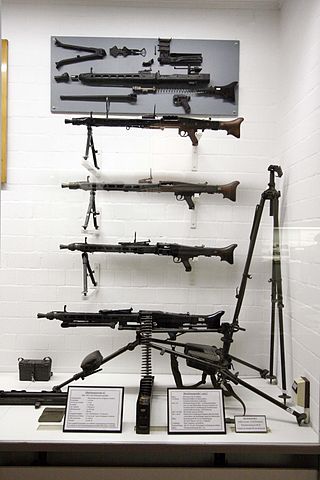
A general-purpose machine gun (GPMG) is an air-cooled, usually belt-fed machine gun that can be adapted flexibly to various tactical roles for light and medium machine guns. A GPMG typically features a quick-change barrel design calibered for various fully powered cartridges such as the 7.62×51mm NATO, 7.62×54mmR, 7.5×54mm French, 7.5×55mm Swiss and 7.92×57mm Mauser, and be configured for mounting to different stabilizing platforms from bipods and tripods to vehicles, aircraft, boats and fortifications, usually as an infantry support weapon or squad automatic weapon.

The Bren gun was a series of light machine guns (LMG) made by Britain in the 1930s and used in various roles until 1992. While best known for its role as the British and Commonwealth forces' primary infantry LMG in World War II, it was also used in the Korean War and saw service throughout the latter half of the 20th century, including the 1982 Falklands War. Although fitted with a bipod, it could also be mounted on a tripod or be vehicle-mounted.
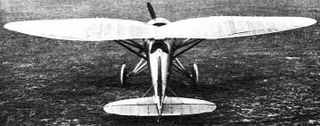
The Aero A.102 was a Czechoslovakian fighter aircraft that flew in prototype form in 1934. It was developed in response to a Czech Air Force requirement of that year, but was passed over in favour of the Avia B.35.

The Aero A.304 was a Czechoslovakian bomber aircraft that first flew in 1937. It had originally been developed as an airliner, the A.204, but when Aero could not find buyers for the design, it was militarised and successfully marketed to the Czechoslovak Air Force. It was also exported to Bulgaria, where it was known as the "Pelikan".

The ZB vz. 26 was a Czechoslovak light machine gun developed in the 1920s, which went on to enter service with several countries. It saw its major use during World War II, and spawned the related ZB vz. 27, vz. 30, and vz. 33. The ZB vz. 26 influenced many other light machine gun designs including the British Bren light machine gun and the Japanese Type 97 heavy tank machine gun. The ZB-26 is famous for its reliability, simple components, quick-change barrel and ease of manufacturing. This light machine gun in the Czechoslovak army was marked as the LK vz. 26. ZB vz. 26 is incorrect nomenclature because "ZB-26" is a factory designation, while "vzor 26" or "vz. 26" is an army designation.
The Type 97 heavy tank machine gun was the standard machine gun used in tanks and armored vehicles of the Imperial Japanese Army during World War II, and as a heavy machine gun by infantry forces. This weapon was not related to the Type 97 aircraft machine gun used in several Japanese Navy aircraft including the Mitsubushi A6M Zero, or the Type 97 automatic cannon used as an anti-tank rifle.

Zbrojovka Brno, s.r.o is a maker of small arms in Brno, Czech Republic, wholly owned by Colt-CZ Group. In the past it also made light artillery, cars, motorcycles, tractors and various tools, such as typewriters and early computers.

The Besa machine gun was a British version of the Czechoslovak ZB-53 air-cooled, belt-fed machine gun.

The ZB-30 and ZB-30J were Czechoslovakian light machine guns that saw extensive use during World War II.
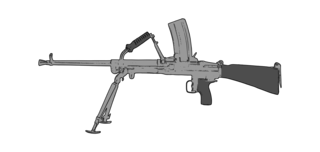
The vz. 52 is a Czechoslovak light machine gun developed after the Second World War for the Czechoslovak Armed Forces.

The LT vz. 34, formally designated as Lehký tank vzor 34 was a Czechoslovak-designed light tank used mainly by Slovakia during World War II. Its suspension was based on that of the Carden-Loyd tankette, of which the Czechs had purchased three, plus a manufacturing license, in 1930. Dissatisfied with the prototypes of the Tančík vz. 33 tankette, the Czech Army decided that it would be easier to design a light tank from scratch rather than modify a tankette's chassis to carry a fully rotating armored turret. 50 were built, the last of which was delivered during 1936, of which the Germans captured 22 - including the prototype, when they occupied Bohemia-Moravia in March 1939, but they promptly scrapped them. The Slovaks seized the remaining 27 when they declared independence from Czechoslovakia at the same time. In Slovak service it only saw combat during the Slovak National Uprising.
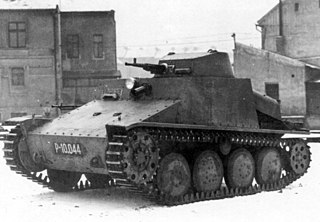
The AH-IV was a Czechoslovak-designed export armored fighting vehicle, classed as either a tankette or light tank, used by Romania during World War II, but having also been acquired by neutral Sweden and Iran. Modified AH-IV versions were built under license by Romania (R-1) and Sweden. The Romanian vehicles saw action on the Eastern Front from Operation Barbarossa to the Vienna offensive. Twenty vehicles were sold after the war to Ethiopia, who used them until the 1980s.

The ZB-53 was a Czechoslovak machine gun. A versatile weapon, it was used both as a squad support weapon, as a mounted machine gun for tanks and other armoured vehicles, and on fixed positions inside Czechoslovak border fortifications. Adopted before the World War II by the armies of Czechoslovakia (as Těžký kulomet vz. 37, Heavy machine gun model 37) and Romania, it was also license-built in the United Kingdom as the Besa machine gun. Following the German invasion of Czechoslovakia, large quantities of the weapon were captured by the Wehrmacht and used during the war under the designation of MG 37(t).
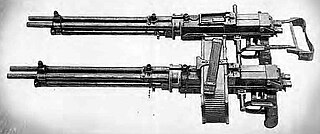
The Type 100 is a double barrel machine gun of Japanese origin. The weapon is gas operated and fed from an overhead magazine. An example can be seen at the Satria Mandala Museum in Jakarta.

This article deals with the history of tanks employed by military forces in Czechoslovakia from the interwar period, and the more conventional tanks designed for the Czechoslovak Army before World War II, and the tanks that ended up as Panzers of the German Wehrmacht during World War II, or in the use of other countries who purchased them before the war began.

The ZB-60 was a heavy machine gun designed by Zbrojovka Brno in Czechoslovakia during the 1930s. Weapons acquired after the German occupation of Czechoslovakia in March 1939 were taken into Wehrmacht service as the 15 mm FlaMG 39(t); Former Yugoslav guns were designated as the 15 mm FlaMG 490(j). The Germans used them as light anti-aircraft guns during World War II. The British developed their 15 mm Besa Mk I from the ZB-60 for service on armored fighting vehicles.
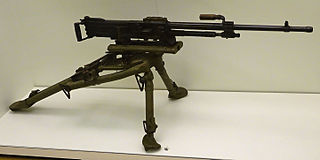
The Alfa M44 was a Spanish machine gun developed during World War II. At this time, stocks of machine guns ran low and no outside source was available. Non-combatant nations found that the belligerent nations were unable to supply as they were preoccupied with meeting their own wartime production needs. It complimented the ZB-26 light machine gun, and replaced the aging Hotchkiss M1914 machine gun. Originally chambered in 7.92×57mm Mauser, in 1955 an updated version chambered in 7.62×51mm NATO was introduced, and was subsequently issued to Spanish troops, sometimes referred to as the M55. Along with Spain, the M44 was also prominently used by Egypt, whose army had standardised on the 7.92×57mm Mauser round. Also in the early 1960s, the Congo government bought a batch of weapons from Spain, including Alfa machine guns, to combat the Simba.

The Fusil ametrallador Oviedo is a Spanish copy of the ZB vz. 26 and ZB vz. 30 Czechoslovak light machine guns.
















